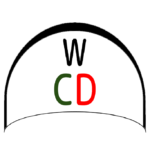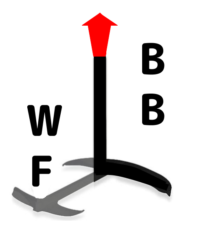This is the first of a series of technique tutorials. If you master these on your own, you will have that much less to learn from me when you get your first coaching session!

If you prefer to watch a video to reading, here you go. I’m updating this page with some additional information about the “L” shaped foot stance that is not included in this video. Soon a new version will be updated to my new Patreon page, my patron’s first exclusive content.
Stand with your back foot over the foil mast pointing across the board and the front foot a little wider than shoulder width apart pointing towards the front of the board. That’s right, I ride with my front foot parallel to the center line of the board. There should be equal pressure on each of your feet. The arch of the back foot should be somewhat downwind of the center line and the front foot should be somewhat upwind. This stance gives your front ankle and knee the best sense of the forward and back angle of the board, which is critical for flight control. The back ankle and knee are in charge of banking side to side to turn. I will cover this in more detail in a future technique post. Thus, your feet make an L shape. Note that your feet need not be at a perfect 90 degree angle to each other to gain this advantage. If that feels too uncomfortable, you can bring your toes together a bit so the front foot isn’t exactly parallel and/or the back isn’t exactly perpendicular. Just try to keep them as close to an “L” shape as you can, within reason! It will feel “weird” at first, but that’s okay! You may not see anyone else recommending this! I did originally read or hear it from someone else though, and once I tried it I saw immediate benefits! At the end of this post, I explain my scientific reasoning this works better on a foil than on a regular surf board or windsurfer, where the more traditional stance was developed.
Stand upright. You do not want to be bending forward at the waist, a common beginner mistake. If the wing starts to overpower you, straighten your back arm first and if you need to dump more power, swing your front arm up (from the shoulder) to bring your wing more overhead. I’d rather see my students fall in while attempting to de-power in time, than break their posture at the waist!
The most common recommendation I have given to date is “keep your front arm straight!” This is the most important aspect of the most efficient and effective posture to take on your board. There are at least 5 reasons. See below if you are curious. Adjusting back arm bend controls power and the front arm controls the height of your wing off of the water. The front arm is pivoted up and down from the shoulder.
Hold your boom or handles with your palms facing down. I used to ride with my front palm facing up, until I realized it would not allow me to do a Heinekin jibe. Even the race jibe is awkward, unless your front palm is down on the boom. So I switched my grip for everything!
Watch where you are going. This is as much for balance as navigation. Use your peripheral vision to help your flight control, until you can feel it without looking at the front of the board.
This is a lot to keep in mind! If any of this is new to you, you will have “bad habits” to break. I promise you, using good, efficient posture will save your energy and make it easier to launch, to learn your jibes, tacks and all other techniques!
For the intellectually curious or skeptical.
Straight front arm explained.
One of the most common mistakes is to bend the front arm. Especially for long time kite surfers! For those students that will find this most difficult to do, I offer the reasons keeping your front arm straight is so important. I hope this inspires you to take on the challenge of breaking this “bad habit!”:
- Efficient and easy wing control, through simpler assignment of jobs between your arms. Use your front arm to position the height of the wing over the water, by pivoting at the shoulder. Use the back arm to control power by changing the distance between your hand and shoulder. So the front shoulder muscles are active and the back bicep. That is all! Simple is good! I will go into this in more detail in a future technique post.
- Improved balance, control and power from the wind (science of vector physics).
- Increasing the distance between your center of mass and the wing gives you more leverage to control the wing.
- When you need horizontal drive to get onto the foil, holding the wing further from the water allows you to bring the wing more vertical without dragging the wing tip.
- Holding the wing further from your body moves it away from the turbulence your body creates. The wing will be able to generate more lift with less drag.
- You reduce your effort by giving the front biceps a rest. Plus because your wing is further from your body, the back arm won’t need to bend as much. The closer your arm is to a 90° angle, the more effort it will take to hold that position.
“L” shaped foot stance explained.
People with lots of experience on other boards may not believe that my “L” foot stance will work. After all, surfers have been using a stance with their feet both across the board successfully forever! But a foil isn’t a surfboard or sailboard. There are two main differences:
- The center of hydrodynamic lift moves around on a surfboard, whereas on a foil it stays at the center of the front foil.
- On a foil, your feet are the mast height above the lifting force. You must keep your weight aligned with the foil mast as you carve turns. The small differences in foot stance width are insignificant compared to the height of the mast. This is the main reason my “L” foot stance works, allowing the same techniques required of either stance to work while gaining the bio-dynamic advantages I describe in my next technique post.
Center of lift
When a rider shifts their weight forward on a planing board, the footprint of that board grows and shifts forward and vise versa. To control this moving target of upward force, your foot stance needs to be wider side to side on the front of the board. My “L” foil stance only controls a narrower more triangular area of potential force locations. So the traditional stance is indeed better for a surfboard or windsurfer:

When a rider shifts their weight forward and back on a foil, the center of lift does not move much! A smaller, more triangular area of control works just fine on a foil. Thus we gain all the bio-mechanical advantages I cite above while retaining full control.
Height of your feet from upward force
On a surfboard your feet are inches above the upward force that you must control with your weight. On a foil board, they are the height of the mast above it! This is the main reason my “L” foot stance works with the same control techniques required of both stances. People are often not aware of how that works. They do it by muscle memory, so I’ll explain briefly.
When carving or banking turns in any board sport, you must shift your weight into the turn to counter centrifugal force. You can make smaller turns by shifting your weight directly into the desired direction, by using the width of your stance to tip your craft into the turn a bit at the same time. To make sharper, more significant course changes, you turn your craft in the opposite direction first. This initial counter turn need not be sharp, so the width of your stance can be minimal; the length of your foot is fine. As soon as your craft shifts out from under you, you will start to fall away from it. When your weight has fallen sufficiently towards the new desired direction of travel, only then can you carve into the new direction. You make a small adjustment to your ankles and knees, realigning your weight “over” your craft (off to the side to counter centrifugal force) and the turn has been initiated.
David is great coach! I wanted to work on jibing and made great progress with his help. He has really figured out how to break things down – and then help you pull them all together. Having him winging right along with you on the water is really invaluable. He has a great eye for identifying what is going wrong, and what you need to do in order to correct it. He is also extremely patient and supportive – I am so glad I found him! If you are considering lessons, you will not find anyone better than David.
David, first of all, is an amazing human! We need more people like him on this planet. 🙂 He tells you exactly what to do and not to do, and he watches you while you practice so he points out your issues and bad habits. I had to unlearn some of the bad habits that were preventing me from progressing. Wing foiling requires a lot of small techniques and David is really good at explaining them.
I was visiting Florida in January for a Foiling trip when I ran into David. I’m always open to learn new techniques so when David mentioned he was a coach I decided to check out a lesson. With only 6 mo’s experience, I was having a lot of issues getting up in light wind. He taught me step by step techniques on the shore to correct my pumping method on a day with maybe 11-12mph winds. It took a little practice, but now I am getting up in 11mph winds No Problem! He also corrected my posture so now my back doesn’t hurt at all while riding for several hours. Very happy I gave him a chance. You won’t be disappointed as he has years of wind experience. 5 ⭐️ for sure!!
Before today I’d taken a two hour Wing foil lesson and then went to Cabarete for a week and took lessons there as well. Today I learned more in the hour with David than I did with the other lessons I’ve taken thus far. He stays with you out on the water and goes step by step with the skills. So helpful. Looking forward to more sessions with him as I continue to learn!
Thanks so much Jenny! You were a great student. It's a pleasure to work with someone that can follow instructions so quickly and well!
David is a very patient and insightful teacher, somehow able to break down a complicated skill into smaller more digestible parts. I came to him a rank beginner (and still am) but his suggestions were enormously helpful. I can’t wait to get back on the water next summer. David inspired me to windsurf many decades ago, and now inspires me to wing!

